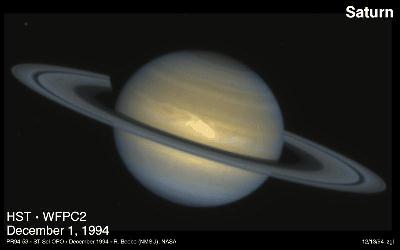General Features of
Saturn
 Saturn is the second most massive planet, and also the second largest in size.
It is a Gas Giant planet with a rotational period of 10-11 hours (depending on
latitude),
and an orbital period of 29.5 years.
The rapid rotation flattens Saturn at the poles by about 10%, making it the
most oblate planet. Its composition is similar to that of Jupiter, being
composed mostly of hydrogen and helium. Like Jupiter, it is mostly liquid,
with a small rocky core expected, but not directly observed, and like Jupiter,
it has an internal heat source (it radiates more energy than it receives)..
Saturn is the second most massive planet, and also the second largest in size.
It is a Gas Giant planet with a rotational period of 10-11 hours (depending on
latitude),
and an orbital period of 29.5 years.
The rapid rotation flattens Saturn at the poles by about 10%, making it the
most oblate planet. Its composition is similar to that of Jupiter, being
composed mostly of hydrogen and helium. Like Jupiter, it is mostly liquid,
with a small rocky core expected, but not directly observed, and like Jupiter,
it has an internal heat source (it radiates more energy than it receives)..
Saturn has the lowest density of any planet, 0.7
g/cc, which is less than that of water. Saturn is of such
low density that it would float in a (gigantic) bathtub. However, you would
not want to put Saturn in a bathtub. Do you know why?
Because it would leave a ring!
The interior is probably similar to Jupiter, with metallic hydrogen responsible
for the strong magnetic field of Saturn. The concentration of helium relative
to hydrogen is somewhat less than for Jupiter. This is thought to be due to
the colder temperature of Saturn.
Although the Hubble Space Telescope can now take very good images of Saturn,
our best information comes from space probes: Pioneer 11, Mariner 11
and 12, and Voyager I and II. Now the Cassini mission has passed
Jupiter and is on its way to Saturn in 2004.
 Saturn is the second most massive planet, and also the second largest in size.
It is a Gas Giant planet with a rotational period of 10-11 hours (depending on
latitude),
and an orbital period of 29.5 years.
The rapid rotation flattens Saturn at the poles by about 10%, making it the
most oblate planet. Its composition is similar to that of Jupiter, being
composed mostly of hydrogen and helium. Like Jupiter, it is mostly liquid,
with a small rocky core expected, but not directly observed, and like Jupiter,
it has an internal heat source (it radiates more energy than it receives)..
Saturn is the second most massive planet, and also the second largest in size.
It is a Gas Giant planet with a rotational period of 10-11 hours (depending on
latitude),
and an orbital period of 29.5 years.
The rapid rotation flattens Saturn at the poles by about 10%, making it the
most oblate planet. Its composition is similar to that of Jupiter, being
composed mostly of hydrogen and helium. Like Jupiter, it is mostly liquid,
with a small rocky core expected, but not directly observed, and like Jupiter,
it has an internal heat source (it radiates more energy than it receives)..